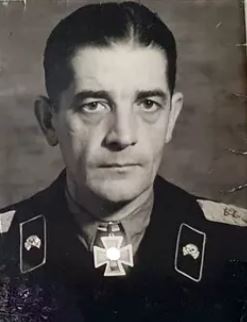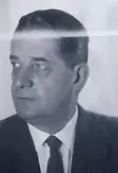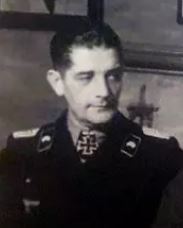Kessler, Arnold (Panzerjäger-Abteilung 61)
- Date of birth:
- April 14th, 1906 (Neunkirchen/Ottweiler, Germany)
- Date of death:
- November 13th, 1967 (Saarbrücken, Germany)
- Nationality:
- German (1933-1945, Third Reich)
Biography
awarded the Ehrensäbel des Oberkommandos des Heeres
Do you have more information about this person? Inform us!
- Period:
- Second World War (1939-1945)
- Period:
- Second World War (1939-1945)
- Period:
- Second World War (1939-1945)
- Period:
- Second World War (1939-1945)
- Period:
- Second World War (1939-1945)
- Rank:
- Major
- Unit:
- Kommandeur, Panzerjäger-Abteilung 61, 11. Panzer-Division
- Awarded on:
- October 4th, 1944
“Saarländer saves the Burgundian Gate - The enemy again expelled from the north bank of the Doubs at Baume les Dames:
In mere sentences of the Wehrmachtbericht there is reported a militarily outstanding deed that is worthy of its own story. A son of Saarland, Major Keßler (commander of a Panzerjägerabteilung), was able to defeat a far numerically and materially superior foe in a critical situation with just a handful of cobbled troops. The enemy was at the time attempting to advance through the open Burgundian gate and thereby begin a trail of destruction into the Reich from the west.
This was the situation on that day: From the area of Lyon the first German elements had broken through to the Rhone valley, led by the 11. Panzer-Division (known to and feared by the enemy as the ‘Ghost Division’). On this hot and cloudless September day elements of the Division entered Besancon. From here to the Swiss border they established a blocking position in front of the enemy divisions presumed to be on their way.
The Panzerjägerabteilung of the Ghost Division, having been badly bloodied by hard battles with the far superior enemy, was on that evening deployed further north of Chamoan and Baume les Dames. From there they were to secure a bridge over the Doubs (a tributary of the Saone). ‘Summer resort mission’, said the comrades who had to stay behind as the small column disappeared behind heavy clouds of dust up the valley road. It would prove to be an exciting summer resort!
In the morning mist, as icy fog crept up the narrow valley of the Doubs, the enemy launched a surprise thrust into the place from the east and south. They had crossed the Doubs during the night and now sat atop a commanding height from which they controlled the main road leading from Besancon to Belfort. An especially critical situation was thus created, as at the moment only weak German forces were on hand in the area. There existed the danger that the enemy force of armoured cars and halftracks (through a swift reinforcement of followup forces in the nocturnal hours) could create a strong bridgehead and thereby block the retreat route of German forces to the north. This would in turn prevent them from blocking the enemy advance to the Burgundian gate.
Major Keßler, in a clear appreciation of the circumstances, decided to act without waiting for orders. Around his small core of exhausted Panzerjäger, he rallied a bicycle company and a number of other straggling soldiers that were in the vicinity. He thus formed a small battle unit and equipped his men with MGs and mortars. In the west of the city he had formed a weak blocking force on a knoll, which had the task of distracting the enemy with small raiding parties. Meanwhile he crept along with his small band of troops, who he had inspired with his own supreme confidence, towards the enemy bridgehead and took up positions north of the city.
It was 14:00 in the afternoon. The sun burned hot over the winding valley of the Doubs. The relentless hammering of machine guns, the firing of mortars, the deadly impact of their shells was seldom heard. Then Major Keßler stormed at the head of his men against the enemy-occupied hill, sub-machine gun in hand. The enemy immediately recognized the threat and defended bitterly. It was man against man. The small and brave band threw the Tunisians off the first hill of the Doubs valley and then — it seems fortune favours the bold — four self-propelled guns of the Divisionsbegleitkompanie entered the scene, for they had followed the noise of battle. A Panzer followed them. Major Keßler dispatched a messenger into the valley, brought up the reinforcements and was then able to fully capitalize on the initial success.
The attacking spirit of his small force swiftly crushed the enemy resistance. The enemy fled back across the Doubs with heavy and bloody losses. The enemy vehicle column on the far side of the river tried in vain to escape. It was almost completely shot up.
As the last bursts of fire died down behind the defeated enemy, a deed of exemplary bravery and of decisive importance for the defense of the Reich’s border was completed. Major Keßler had, with a handful of men, halted the planned enemy thrust through the open Burgundian Gate and enabled the Division and the following German formations to move back along the road to Belfort. From there these troops could definitively block the Burgundian Gate.
Fulfilling his duties with supreme, swift and mindful bravery — these were the soldierly virtues shown by this son of Saarland. These were the virtues shown by German soldiers on this day, which brought them the necessary power to alter the destiny of Europe.”
Sources
- Photo 1:
- Photo 2:
- Photo 3:
- - GERD NIETRUG, Die Ritterkreuzträger des Saarlandes 1939-1945, VDM Heinz Nickel, 2004.









